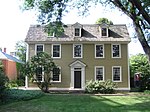John Ward House (Salem, Massachusetts)
1684 establishments in the Massachusetts Bay ColonyHistoric district contributing properties in MassachusettsHistoric house museums in MassachusettsHouses completed in 1684Houses in Salem, Massachusetts ... and 6 more
Houses on the National Register of Historic Places in Essex County, MassachusettsNRHP infobox with nocatNational Historic Landmarks in MassachusettsNational Register of Historic Places in Salem, MassachusettsPeabody Essex MuseumUse mdy dates from August 2023

The John Ward House is a National Historic Landmark at 9 Brown Street in Salem, Massachusetts, United States. With an early construction history between 1684 and 1723, it is an excellent example of First Period architecture, and as the subject of an early 20th-century restoration by antiquarian George Francis Dow, it is an important example of the restoration techniques. Now owned by the Peabody Essex Museum, it is also one of the first colonial-era houses in the United States to be opened as a museum. It was designated a National Historic Landmark in 1968.
Excerpt from the Wikipedia article John Ward House (Salem, Massachusetts) (License: CC BY-SA 3.0, Authors, Images).John Ward House (Salem, Massachusetts)
Church Street, Salem
Geographical coordinates (GPS) Address Nearby Places Show on map
Geographical coordinates (GPS)
| Latitude | Longitude |
|---|---|
| N 42.522777777778 ° | E -70.893333333333 ° |
Address
Church St Lot
Church Street
01970 Salem
Massachusetts, United States
Open on Google Maps









